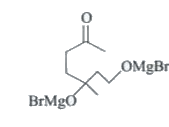AcetaldehydeHCN−−→XH2O/H+−−−−−→YHeat−−→Z
In the above sequence, the end product Z is
Prop-2-enoic acid
But-2-enoic acid
Lactic acid
Tartaric acid
The correct Answer is:A
To solve the problem step by step, we will analyze the reaction sequence involving acetaldehyde and determine the final product Z.
Step 1: Identify Acetaldehyde
Acetaldehyde is represented by the formula CH₃CHO. It has a carbonyl group (C=O) and is the simplest aldehyde.
Step 2: Reaction with HCN
When acetaldehyde reacts with hydrogen cyanide (HCN), the cyanide ion (CN⁻) acts as a nucleophile and attacks the carbonyl carbon of acetaldehyde. This results in the formation of a cyanohydrin. The reaction can be summarized as follows:
CH3CHO+HCN→CH3C(OH)(CN)
This compound is referred to as the cyanohydrin, which we will label as X.
Step 3: Acidic Hydrolysis
Next, we treat the cyanohydrin (X) with water (H₂O) in the presence of an acid (H⁺). This process is known as acidic hydrolysis. During this reaction, the CN group is converted into a carboxylic acid (COOH). The reaction can be represented as:
CH3C(OH)(CN)+H2O/H+→CH3C(OH)(COOH)
This product is now labeled as Y, which is 2-hydroxybutanoic acid (or hydroxybutyric acid).
Step 4: Heating the Product
The next step involves heating the compound Y. When heated, a dehydration reaction occurs where a water molecule is eliminated. This leads to the formation of a double bond between the carbon atoms. The reaction can be summarized as follows:
CH3C(OH)(COOH)Heat−−→CH2=C(COOH)
This product is now labeled as Z.
Step 5: Naming the Final Product
The final product Z can be identified as prop-2-enoic acid (also known as acrylic acid). The structure shows a double bond between the second and third carbon atoms, with a carboxylic acid group at one end.
Conclusion
Thus, the end product Z is prop-2-enoic acid.
Final Answer
The end product Z is prop-2-enoic acid.
---
Acetaldehyde is represented by the formula CH₃CHO. It has a carbonyl group (C=O) and is the simplest aldehyde.
When acetaldehyde reacts with hydrogen cyanide (HCN), the cyanide ion (CN⁻) acts as a nucleophile and attacks the carbonyl carbon of acetaldehyde. This results in the formation of a cyanohydrin. The reaction can be summarized as follows:
Next, we treat the cyanohydrin (X) with water (H₂O) in the presence of an acid (H⁺). This process is known as acidic hydrolysis. During this reaction, the CN group is converted into a carboxylic acid (COOH). The reaction can be represented as:
The next step involves heating the compound Y. When heated, a dehydration reaction occurs where a water molecule is eliminated. This leads to the formation of a double bond between the carbon atoms. The reaction can be summarized as follows:
The final product Z can be identified as prop-2-enoic acid (also known as acrylic acid). The structure shows a double bond between the second and third carbon atoms, with a carboxylic acid group at one end.
Thus, the end product Z is prop-2-enoic acid.
The end product Z is prop-2-enoic acid.
Similar Questions
Knowledge Check

H3CMgBr−−−−−→XH3CMgBr−−−−−→YH3CMgBr−−−−−→Z, then :A B
B C
C D
D
SiCl4H2O−−→XHeat−−→YNaOH−−−→Z
find X,Y,Z.ASiO2SiNaSiBSi(OH)4SiO2Na2SiO3CSi(OH)4SiSiO2DSiO2SiCI4Na2SiO3For the sequence of reactions, AC2H5MgI−−−−−→etherBH2O/H+−−−−−→ tert-Pentyl alcohol. The compound A in the sequence is :
A2-ButanoneBAcetaldehydeCAcetoneDPropanal
C6H5N2ClSnCl2/HClA→C6H5CHO−−−−−−→(B)
The product (B) in the above sequence of reaction is
View SolutionCH3CH2ClNaCN−−−→XNi/H2−−−→YAcetic−−−−−→anhydrideZ
Z in the above reaction sequence is .
View SolutionC6H6HNO3−−−→H2SO4PSn/HCl−−−−→QNaNO2−−−−→HClRH3PO2−−−→H2OS
The end product S in the given sequence of reactions is
View SolutionN2+H2→[X](g)CO2,Pressure−−−−−−−→[Y]Heat−−→[Z]+H2O In the above sequence of reaction, [Y] and [Z] are respectively.
View SolutionIn the given reaction sequence
C6H5NO2Sn/HCl−−−−→ANaNO2+HCl−−−−−−−−→BCuCN/HCN−−−−−−−−→CH2∅H⊕−−−−→ΔD
Which one is not correct ?
View Solution
